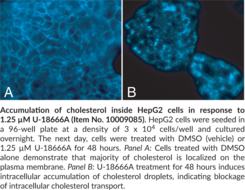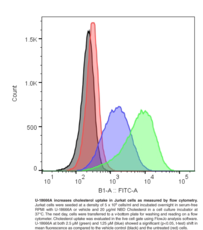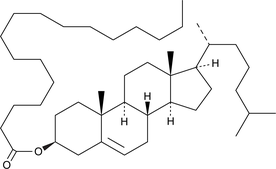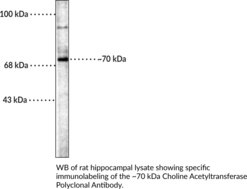Cayman
Showing 15151–15300 of 45550 results
-
CHM-1 is an inhibitor of tubulin polymerization (IC50 = 0.68 µM) with anticancer activity.{57149} It inhibits colchicine (Item No. 9000760) tubulin binding by 39% when used at a concentration of 5 µM. CHM-1 inhibits the growth of K562, NCI H226, HCT116, OVCAR-3, RXF 393L, SK-MEL-5, SF-268, and SF-295 cancer cells (mean GI50 = 130 nM). It induces apoptosis in HA22T hepatocellular carcinoma cells in a concentration-dependent manner.{57150} CHM-1 (10 mg/kg) reduces tumor volume and increases survival in an HA22T mouse xenograft model.
Brand:CaymanSKU:27647 - 10 mgAvailable on backorder
-
CHM-1 is an inhibitor of tubulin polymerization (IC50 = 0.68 µM) with anticancer activity.{57149} It inhibits colchicine (Item No. 9000760) tubulin binding by 39% when used at a concentration of 5 µM. CHM-1 inhibits the growth of K562, NCI H226, HCT116, OVCAR-3, RXF 393L, SK-MEL-5, SF-268, and SF-295 cancer cells (mean GI50 = 130 nM). It induces apoptosis in HA22T hepatocellular carcinoma cells in a concentration-dependent manner.{57150} CHM-1 (10 mg/kg) reduces tumor volume and increases survival in an HA22T mouse xenograft model.
Brand:CaymanSKU:27647 - 5 mgAvailable on backorder
-
CHM-122 (Item No. 22043) is an analytical reference standard that is structurally categorized as a cannabinoid. The physiological and toxicological properties of this compound are not known. This product is intended for research and forensic applications.
Brand:CaymanSKU:22043 -Out of stock
-
CHM-122 (Item No. 22043) is an analytical reference standard that is structurally categorized as a cannabinoid. The physiological and toxicological properties of this compound are not known. This product is intended for research and forensic applications.
Brand:CaymanSKU:22043 -Out of stock
-
Cho-Arg is a steroid-based cationic lipid that contains a cholesterol skeleton coupled to an L-arginine head group.{44005} It forms a complex with plasmid DNA and decreases plasmid DNA migration in an agarose-gel retardant assay at charge ratios greater than or equal to 4. Cho-Arg facilitates transfection of plasmid DNA into H1299 and HeLa cells in the presence or absence of fetal bovine serum, an effect that is reversed by the lipid raft-mediated endocytosis inhibitor methyl-β-cyclodextrin (Item No. 21633) and the caveolae-mediated endocytosis inhibitor genistein (Item No. 10005167). It is cytotoxic to H1299 cells (IC50 = 88.5 μg/ml).
Brand:CaymanSKU:25943 - 1 mgAvailable on backorder
-
Cho-Arg is a steroid-based cationic lipid that contains a cholesterol skeleton coupled to an L-arginine head group.{44005} It forms a complex with plasmid DNA and decreases plasmid DNA migration in an agarose-gel retardant assay at charge ratios greater than or equal to 4. Cho-Arg facilitates transfection of plasmid DNA into H1299 and HeLa cells in the presence or absence of fetal bovine serum, an effect that is reversed by the lipid raft-mediated endocytosis inhibitor methyl-β-cyclodextrin (Item No. 21633) and the caveolae-mediated endocytosis inhibitor genistein (Item No. 10005167). It is cytotoxic to H1299 cells (IC50 = 88.5 μg/ml).
Brand:CaymanSKU:25943 - 10 mgAvailable on backorder
-
Cho-Arg is a steroid-based cationic lipid that contains a cholesterol skeleton coupled to an L-arginine head group.{44005} It forms a complex with plasmid DNA and decreases plasmid DNA migration in an agarose-gel retardant assay at charge ratios greater than or equal to 4. Cho-Arg facilitates transfection of plasmid DNA into H1299 and HeLa cells in the presence or absence of fetal bovine serum, an effect that is reversed by the lipid raft-mediated endocytosis inhibitor methyl-β-cyclodextrin (Item No. 21633) and the caveolae-mediated endocytosis inhibitor genistein (Item No. 10005167). It is cytotoxic to H1299 cells (IC50 = 88.5 μg/ml).
Brand:CaymanSKU:25943 - 5 mgAvailable on backorder
-
Cholenic acid is a monohydroxy bile acid.{55080} It is a cholesterol oxidation product formed by 7α-hydroxylation of 27-hydroxycholesterol (Item Nos. 14790 | 14791), as well as a precursor in the biosynthesis of chenodeoxycholic acid (Item No. 10011286). Levels of cholenic acid are increased in patients with neonatal liver disease harboring mutations in CYP7A1, the gene encoding 7α-hydroxylase, as well as in patients with intrahepatic and extrahepatic cholestasis.{55081,55082}
Brand:CaymanSKU:29543 - 1 gAvailable on backorder
-
Cholenic acid is a monohydroxy bile acid.{55080} It is a cholesterol oxidation product formed by 7α-hydroxylation of 27-hydroxycholesterol (Item Nos. 14790 | 14791), as well as a precursor in the biosynthesis of chenodeoxycholic acid (Item No. 10011286). Levels of cholenic acid are increased in patients with neonatal liver disease harboring mutations in CYP7A1, the gene encoding 7α-hydroxylase, as well as in patients with intrahepatic and extrahepatic cholestasis.{55081,55082}
Brand:CaymanSKU:29543 - 100 mgAvailable on backorder
-
Cholenic acid is a monohydroxy bile acid.{55080} It is a cholesterol oxidation product formed by 7α-hydroxylation of 27-hydroxycholesterol (Item Nos. 14790 | 14791), as well as a precursor in the biosynthesis of chenodeoxycholic acid (Item No. 10011286). Levels of cholenic acid are increased in patients with neonatal liver disease harboring mutations in CYP7A1, the gene encoding 7α-hydroxylase, as well as in patients with intrahepatic and extrahepatic cholestasis.{55081,55082}
Brand:CaymanSKU:29543 - 250 mgAvailable on backorder
-
Cholenic acid is a monohydroxy bile acid.{55080} It is a cholesterol oxidation product formed by 7α-hydroxylation of 27-hydroxycholesterol (Item Nos. 14790 | 14791), as well as a precursor in the biosynthesis of chenodeoxycholic acid (Item No. 10011286). Levels of cholenic acid are increased in patients with neonatal liver disease harboring mutations in CYP7A1, the gene encoding 7α-hydroxylase, as well as in patients with intrahepatic and extrahepatic cholestasis.{55081,55082}
Brand:CaymanSKU:29543 - 500 mgAvailable on backorder
-
Cholestanol is a cholesterol metabolite formed by oxidation and an intermediate in the biosynthesis of chenodeoxycholic acid (Item No. 10011286).{47049} Cholestanol (10 µg/ml) induces apoptosis in cornea and lens epithelial cells and increases the activity of IL-1β converting enzyme (ICE) and CPP32 proteases.{47050} Dietary administration of 1% cholestanol to mice increases serum and liver cholestanol levels and leads to corneal opacities and gallstones and in rats it leads to cholestanol deposition in the cerebellum.{47051} Cholestanol levels are increased in plasma of patients with cerebrotendinous xanthomatosis (CTX), a disease characterized by a deficiency in the mitochondrial enzyme sterol 27-hydrolylase (CYP27A1) that leads to progressive neurological symptoms.{47052}
Brand:CaymanSKU:9003101 - 10 gAvailable on backorder
-
Cholestanol is a cholesterol metabolite formed by oxidation and an intermediate in the biosynthesis of chenodeoxycholic acid (Item No. 10011286).{47049} Cholestanol (10 µg/ml) induces apoptosis in cornea and lens epithelial cells and increases the activity of IL-1β converting enzyme (ICE) and CPP32 proteases.{47050} Dietary administration of 1% cholestanol to mice increases serum and liver cholestanol levels and leads to corneal opacities and gallstones and in rats it leads to cholestanol deposition in the cerebellum.{47051} Cholestanol levels are increased in plasma of patients with cerebrotendinous xanthomatosis (CTX), a disease characterized by a deficiency in the mitochondrial enzyme sterol 27-hydrolylase (CYP27A1) that leads to progressive neurological symptoms.{47052}
Brand:CaymanSKU:9003101 - 25 gAvailable on backorder
-
Cholestanol is a cholesterol metabolite formed by oxidation and an intermediate in the biosynthesis of chenodeoxycholic acid (Item No. 10011286).{47049} Cholestanol (10 µg/ml) induces apoptosis in cornea and lens epithelial cells and increases the activity of IL-1β converting enzyme (ICE) and CPP32 proteases.{47050} Dietary administration of 1% cholestanol to mice increases serum and liver cholestanol levels and leads to corneal opacities and gallstones and in rats it leads to cholestanol deposition in the cerebellum.{47051} Cholestanol levels are increased in plasma of patients with cerebrotendinous xanthomatosis (CTX), a disease characterized by a deficiency in the mitochondrial enzyme sterol 27-hydrolylase (CYP27A1) that leads to progressive neurological symptoms.{47052}
Brand:CaymanSKU:9003101 - 5 gAvailable on backorder
-
Cholestanone is a cholesterol metabolite that has a keto group in place of the 3-hydroxy group on cholesterol.{48122} It decreases TGF-β-induced Smad2 phosphorylation and TGF-β expression and prevents inhibition of DNA synthesis by TGF-β in Mv1Lu cells when used at a concentration of 50 µg/ml.{48123} Increased fecal excretion of cholestenone is correlated with an increased risk of colorectal cancer. Cholestenone reduces serum cholesterol levels in a variety of animal models but is toxic to rats when administered at doses of 700-1,000 mg/kg per day, inducing hypertrophy in and reducing the activity of the adrenal gland.{48124} It has been used as synthetic intermediate in the synthesis of steroids.{48125}
Brand:CaymanSKU:25713 - 10 gAvailable on backorder
-
Cholestanone is a cholesterol metabolite that has a keto group in place of the 3-hydroxy group on cholesterol.{48122} It decreases TGF-β-induced Smad2 phosphorylation and TGF-β expression and prevents inhibition of DNA synthesis by TGF-β in Mv1Lu cells when used at a concentration of 50 µg/ml.{48123} Increased fecal excretion of cholestenone is correlated with an increased risk of colorectal cancer. Cholestenone reduces serum cholesterol levels in a variety of animal models but is toxic to rats when administered at doses of 700-1,000 mg/kg per day, inducing hypertrophy in and reducing the activity of the adrenal gland.{48124} It has been used as synthetic intermediate in the synthesis of steroids.{48125}
Brand:CaymanSKU:25713 - 5 gAvailable on backorder
-
Cholesterol is a major sterol produced in mammalian cells that is required for cell viability and proliferation.{39788} It is a component of mammalian cell membranes that interacts with membrane phospholipids, sphingolipids, and proteins to influence their behavior. Cholesterol is a precursor of steroid hormones, bile acids, and the active form of vitamin D. Impaired cholesterol homeostasis is related to development of various diseases including fatty liver, diabetes, gallstones, dyslipidemia, atherosclerosis, heart attack, and stroke.{39789}
Brand:CaymanSKU:9003100 - 100 gAvailable on backorder
-
Cholesterol is a major sterol produced in mammalian cells that is required for cell viability and proliferation.{39788} It is a component of mammalian cell membranes that interacts with membrane phospholipids, sphingolipids, and proteins to influence their behavior. Cholesterol is a precursor of steroid hormones, bile acids, and the active form of vitamin D. Impaired cholesterol homeostasis is related to development of various diseases including fatty liver, diabetes, gallstones, dyslipidemia, atherosclerosis, heart attack, and stroke.{39789}
Brand:CaymanSKU:9003100 - 250 gAvailable on backorder
-
Cholesterol is a major sterol produced in mammalian cells that is required for cell viability and proliferation.{39788} It is a component of mammalian cell membranes that interacts with membrane phospholipids, sphingolipids, and proteins to influence their behavior. Cholesterol is a precursor of steroid hormones, bile acids, and the active form of vitamin D. Impaired cholesterol homeostasis is related to development of various diseases including fatty liver, diabetes, gallstones, dyslipidemia, atherosclerosis, heart attack, and stroke.{39789}
Brand:CaymanSKU:9003100 - 500 gAvailable on backorder
-
Brand:CaymanSKU:10008052 - 1 ea
Available on backorder
-
Brand:CaymanSKU:10008052 - 5 ea
Available on backorder
-
Brand:CaymanSKU:10008054 - 1 ea
Available on backorder
-
Brand:CaymanSKU:10008057 - 1 ea
Available on backorder
-
Brand:CaymanSKU:10008057 - 5 ea
Available on backorder
-
Brand:CaymanSKU:10008055 - 1 ea
Available on backorder
-
Brand:CaymanSKU:10008055 - 5 ea
Available on backorder
-
Brand:CaymanSKU:10008056 - 1 ea
Available on backorder
-
Brand:CaymanSKU:10008056 - 5 ea
Available on backorder
-
Brand:CaymanSKU:10008053 - 1 ea
Available on backorder
-
Brand:CaymanSKU:10008053 - 5 ea
Available on backorder
-
The mechanism for the movement of cholesterol from intracellular sites to their ultimate cellular destination is an unresolved question of fundamental importance to cell biology and medicine. Thus, defining mechanisms of intracellular cholesterol transport and identifying the cellular factors involved are therefore of great interest. Cayman’s Cholesterol Cell-Based Detection Assay Kit includes Filipin III, Fixative, and Wash Buffer in a ready to use format. It provides a simple fluorometric method to study mechanisms and biological factors that regulate cholesterol metabolism or movement within cells. A cholesterol trafficking inhibitor, U-18666A, is included as a positive control.
Brand:CaymanSKU:10009779 - 2 x 96 wellsAvailable on backorder
-
Brand:CaymanSKU:10009868 - 1 ea
Available on backorder
-
Cholesterol, particularly in the form of low density lipoproteins (LDL), is well understood to be associated with increased risk of coronary heart disease. The measurement of cholesterol is one of the most common tests performed in the clinical laboratory setting. However, simple and easy assays for cholesterol in the research lab have not been readily available. Cayman’s Cholesterol Fluorometric Assay provides a simple fluorometric method for the sensitive quantitation of total cholesterol in plasma or serum. In our assay, cholesteryl esters in the sample are first hydrolyzed by cholesterol esterase. All cholesterol, whether previously esterified or existing free in the circulation, is then oxidized by cholesterol oxidase to the corresponding ketone and hydrogen peroxide. ADHP (10-acetyl-3,7-dihydroxyphenoxazine) is utilized as a highly sensitive and stable probe for hydrogen peroxide. Horseradish peroxidase catalyzes the reaction of ADHP with hydrogen peroxide to yield the highly fluorescent product resorufin which can be monitored using excitation wavelengths of 530-540 nm and emission wavelengths of 585-595 nm.
Brand:CaymanSKU:10007640 - 480 wellsAvailable on backorder
-
Cholesterol, particularly in the form of low density lipoproteins (LDL), is well understood to be associated with increased risk of coronary heart disease. The measurement of cholesterol is one of the most common tests performed in the clinical laboratory setting. However, simple and easy assays for cholesterol in the research lab have not been readily available. Cayman’s Cholesterol Fluorometric Assay provides a simple fluorometric method for the sensitive quantitation of total cholesterol in plasma or serum. In our assay, cholesteryl esters in the sample are first hydrolyzed by cholesterol esterase. All cholesterol, whether previously esterified or existing free in the circulation, is then oxidized by cholesterol oxidase to the corresponding ketone and hydrogen peroxide. ADHP (10-acetyl-3,7-dihydroxyphenoxazine) is utilized as a highly sensitive and stable probe for hydrogen peroxide. Horseradish peroxidase catalyzes the reaction of ADHP with hydrogen peroxide to yield the highly fluorescent product resorufin which can be monitored using excitation wavelengths of 530-540 nm and emission wavelengths of 585-595 nm.
Brand:CaymanSKU:10007640 - 96 wellsAvailable on backorder
-
Cholesterol sulfate is an endogenous component of cell membranes where it serves as a substrate for steroid synthesis, influences lipid metabolism, stabilizes cell membranes, regulates the activity of functional proteins, and plays a role in keratinocyte differentiation and development of the epidermal barrier.{24230} This synthetic formulation can be used to form nonconventional liposomes in order to study cellular membrane properties.{24229}
Brand:CaymanSKU:- -
Cholesterol sulfate is an endogenous component of cell membranes where it serves as a substrate for steroid synthesis, influences lipid metabolism, stabilizes cell membranes, regulates the activity of functional proteins, and plays a role in keratinocyte differentiation and development of the epidermal barrier.{24230} This synthetic formulation can be used to form nonconventional liposomes in order to study cellular membrane properties.{24229}
Brand:CaymanSKU:- -
Cholesterol sulfate is an endogenous component of cell membranes where it serves as a substrate for steroid synthesis, influences lipid metabolism, stabilizes cell membranes, regulates the activity of functional proteins, and plays a role in keratinocyte differentiation and development of the epidermal barrier.{24230} This synthetic formulation can be used to form nonconventional liposomes in order to study cellular membrane properties.{24229}
Brand:CaymanSKU:- -
Cholesterol sulfate is an endogenous component of cell membranes where it serves as a substrate for steroid synthesis, influences lipid metabolism, stabilizes cell membranes, regulates the activity of functional proteins, and plays a role in keratinocyte differentiation and development of the epidermal barrier.{24230} This synthetic formulation can be used to form nonconventional liposomes in order to study cellular membrane properties.{24229}
Brand:CaymanSKU:- -
Maintaining body cholesterol homeostasis is critical for normal physiological functions and is achieved by a highly regulated balance of de novo synthesis, dietary cholesterol absorption, biliary clearance, and excretion. However, the mechanisms controlling cholesterol absorption are not well understood. A better understanding of the relationship between cholesterol absorption and synthesis may allow for the development of powerful novel strategies for the prevention and treatment of hypercholesterolemia. Cayman’s Cholesterol Uptake Cell-Based Assay Kit provides a convenient tool for studying cholesterol absorption modulators. The kit employs NBD Cholesterol, a fluorescently tagged cholesterol, as a probe for the detection of cholesterol taken up by cultured cells. U-18666A, a cholesterol intracellular trafficking inhibitor, is included as a positive control.
Brand:CaymanSKU:600440 - 1 eaAvailable on backorder
-
Cholesterol α-linolenate is a cholesterol ester found in fatty streaks and atherosclerotic plaques isolated from human aorta.{37246}
Brand:CaymanSKU:22596 -Out of stock
-
Cholesterol α-linolenate is a cholesterol ester found in fatty streaks and atherosclerotic plaques isolated from human aorta.{37246}
Brand:CaymanSKU:22596 -Out of stock
-
Cholesterol β-D-glucoside is a derivative of cholesterol that contains β-D-glucose (Item No. 16775). It is formed from cholesterol and glucosylceramide by β-glucosidase 1.{47305} It activates heat shock transcription factor 1 (Hsf1) in response to heat shock, which increases the expression of heat shock protein 70 (Hsp70) in TIG-3 human fetal lung fibroblasts when used at a concentration of 10 µM.{47306} Cholesterol β-D-glucoside (100 mg/kg) prevents ulcer formation following cold-restraint stress and increases Hsf1 activity, as well as Hsp70 expression and protein levels in rat gastric mucosa.{47307} [Matreya, LLC. Catalog No. 1940]
Brand:CaymanSKU:26713 - 1 mgAvailable on backorder
-
Cholesterol β-D-glucoside is a derivative of cholesterol that contains β-D-glucose (Item No. 16775). It is formed from cholesterol and glucosylceramide by β-glucosidase 1.{47305} It activates heat shock transcription factor 1 (Hsf1) in response to heat shock, which increases the expression of heat shock protein 70 (Hsp70) in TIG-3 human fetal lung fibroblasts when used at a concentration of 10 µM.{47306} Cholesterol β-D-glucoside (100 mg/kg) prevents ulcer formation following cold-restraint stress and increases Hsf1 activity, as well as Hsp70 expression and protein levels in rat gastric mucosa.{47307} [Matreya, LLC. Catalog No. 1940]
Brand:CaymanSKU:26713 - 10 mgAvailable on backorder
-
Cholesterol β-D-glucoside is a derivative of cholesterol that contains β-D-glucose (Item No. 16775). It is formed from cholesterol and glucosylceramide by β-glucosidase 1.{47305} It activates heat shock transcription factor 1 (Hsf1) in response to heat shock, which increases the expression of heat shock protein 70 (Hsp70) in TIG-3 human fetal lung fibroblasts when used at a concentration of 10 µM.{47306} Cholesterol β-D-glucoside (100 mg/kg) prevents ulcer formation following cold-restraint stress and increases Hsf1 activity, as well as Hsp70 expression and protein levels in rat gastric mucosa.{47307} [Matreya, LLC. Catalog No. 1940]
Brand:CaymanSKU:26713 - 5 mgAvailable on backorder
-
Cholesterol-d6 is intended for use as an internal standard for the quantification of cholesterol by GC- or LC-MS. Cholesterol is a major sterol produced in mammalian cells that is required for cell viability and proliferation.{39788} It is a component of mammalian cell membranes that interacts with membrane phospholipids, sphingolipids, and proteins to influence their behavior. Cholesterol is a precursor of steroid hormones, bile acids, and the active form of vitamin D. Impaired cholesterol homeostasis is related to development of various diseases including fatty liver, diabetes, gallstones, dyslipidemia, atherosclerosis, heart attack, and stroke.{39789}
Brand:CaymanSKU:25546 - 1 mgAvailable on backorder
-
Cholesterol-d6 is intended for use as an internal standard for the quantification of cholesterol by GC- or LC-MS. Cholesterol is a major sterol produced in mammalian cells that is required for cell viability and proliferation.{39788} It is a component of mammalian cell membranes that interacts with membrane phospholipids, sphingolipids, and proteins to influence their behavior. Cholesterol is a precursor of steroid hormones, bile acids, and the active form of vitamin D. Impaired cholesterol homeostasis is related to development of various diseases including fatty liver, diabetes, gallstones, dyslipidemia, atherosclerosis, heart attack, and stroke.{39789}
Brand:CaymanSKU:25546 - 10 mgAvailable on backorder
-
Cholesterol-d6 is intended for use as an internal standard for the quantification of cholesterol by GC- or LC-MS. Cholesterol is a major sterol produced in mammalian cells that is required for cell viability and proliferation.{39788} It is a component of mammalian cell membranes that interacts with membrane phospholipids, sphingolipids, and proteins to influence their behavior. Cholesterol is a precursor of steroid hormones, bile acids, and the active form of vitamin D. Impaired cholesterol homeostasis is related to development of various diseases including fatty liver, diabetes, gallstones, dyslipidemia, atherosclerosis, heart attack, and stroke.{39789}
Brand:CaymanSKU:25546 - 5 mgAvailable on backorder
-
Cholesterol-d7 is intended for use as an internal standard for the quantification of cholesterol by GC- or LC-MS. Cholesterol is a major sterol produced in mammalian cells that is required for cell viability and proliferation.{39788} It is a component of mammalian cell membranes that interacts with membrane phospholipids, sphingolipids, and proteins to influence their behavior. Cholesterol is a precursor of steroid hormones, bile acids, and the active form of vitamin D. Impaired cholesterol homeostasis is related to development of various diseases including fatty liver, diabetes, gallstones, dyslipidemia, atherosclerosis, heart attack, and stroke.{39789}
Brand:CaymanSKU:25265 - 1 mgAvailable on backorder
-
Cholesterol-d7 is intended for use as an internal standard for the quantification of cholesterol by GC- or LC-MS. Cholesterol is a major sterol produced in mammalian cells that is required for cell viability and proliferation.{39788} It is a component of mammalian cell membranes that interacts with membrane phospholipids, sphingolipids, and proteins to influence their behavior. Cholesterol is a precursor of steroid hormones, bile acids, and the active form of vitamin D. Impaired cholesterol homeostasis is related to development of various diseases including fatty liver, diabetes, gallstones, dyslipidemia, atherosclerosis, heart attack, and stroke.{39789}
Brand:CaymanSKU:25265 - 10 mgAvailable on backorder
-
Cholesterol-d7 is intended for use as an internal standard for the quantification of cholesterol by GC- or LC-MS. Cholesterol is a major sterol produced in mammalian cells that is required for cell viability and proliferation.{39788} It is a component of mammalian cell membranes that interacts with membrane phospholipids, sphingolipids, and proteins to influence their behavior. Cholesterol is a precursor of steroid hormones, bile acids, and the active form of vitamin D. Impaired cholesterol homeostasis is related to development of various diseases including fatty liver, diabetes, gallstones, dyslipidemia, atherosclerosis, heart attack, and stroke.{39789}
Brand:CaymanSKU:25265 - 5 mgAvailable on backorder
-
Cholesteryl 11,14-eicosadienoate is a cholesterol ester.{46098} It has been used as a synthetic intermediate in the synthesis of cholesterol methyl esters.
Brand:CaymanSKU:26467 - 100 mgAvailable on backorder
-
Cholesteryl 11,14-eicosadienoate is a cholesterol ester.{46098} It has been used as a synthetic intermediate in the synthesis of cholesterol methyl esters.
Brand:CaymanSKU:26467 - 250 mgAvailable on backorder
-
Cholesteryl 11,14-eicosadienoate is a cholesterol ester.{46098} It has been used as a synthetic intermediate in the synthesis of cholesterol methyl esters.
Brand:CaymanSKU:26467 - 50 mgAvailable on backorder
-
Cholesteryl 11,14-eicosadienoate is a cholesterol ester.{46098} It has been used as a synthetic intermediate in the synthesis of cholesterol methyl esters.
Brand:CaymanSKU:26467 - 500 mgAvailable on backorder
-
Cholesteryl arachidonate is a cholesterol ester that is found in plasma and the adrenal gland.{42068} It is a component of low-density lipoprotein (LDL) and oxidiation of the arachidonate moiety contributes to macrophage activation and foam cell formation in atherosclerosis.{42069} Cholesteryl arachidonate undergoes hydrolysis to release arachidonic acid during ACTH-stimulated prostaglandin synthesis in rat adrenocortical cells.{42070} Levels of cholesteryl arachidonate are increased in the bronchoalveolar lavage fluid (BALF) in pediatric cystic fibrosis patients compared to healthy controls as well as in placentas of women with chorioamnionitis.{42071,42072}
Brand:CaymanSKU:22595 -Out of stock
-
Cholesteryl arachidonate is a cholesterol ester that is found in plasma and the adrenal gland.{42068} It is a component of low-density lipoprotein (LDL) and oxidiation of the arachidonate moiety contributes to macrophage activation and foam cell formation in atherosclerosis.{42069} Cholesteryl arachidonate undergoes hydrolysis to release arachidonic acid during ACTH-stimulated prostaglandin synthesis in rat adrenocortical cells.{42070} Levels of cholesteryl arachidonate are increased in the bronchoalveolar lavage fluid (BALF) in pediatric cystic fibrosis patients compared to healthy controls as well as in placentas of women with chorioamnionitis.{42071,42072}
Brand:CaymanSKU:22595 -Out of stock
-
Cholesteryl arachidonate is a cholesterol ester that is found in plasma and the adrenal gland.{42068} It is a component of low-density lipoprotein (LDL) and oxidiation of the arachidonate moiety contributes to macrophage activation and foam cell formation in atherosclerosis.{42069} Cholesteryl arachidonate undergoes hydrolysis to release arachidonic acid during ACTH-stimulated prostaglandin synthesis in rat adrenocortical cells.{42070} Levels of cholesteryl arachidonate are increased in the bronchoalveolar lavage fluid (BALF) in pediatric cystic fibrosis patients compared to healthy controls as well as in placentas of women with chorioamnionitis.{42071,42072}
Brand:CaymanSKU:22595 -Out of stock
-
Cholesteryl behenate is a cholesterol ester.{47142} It has been used as an internal standard for the quantification of cholesterol esters in human meibum samples.
Brand:CaymanSKU:26466 - 100 mgAvailable on backorder
-
Cholesteryl behenate is a cholesterol ester.{47142} It has been used as an internal standard for the quantification of cholesterol esters in human meibum samples.
Brand:CaymanSKU:26466 - 25 mgAvailable on backorder
-
Cholesteryl behenate is a cholesterol ester.{47142} It has been used as an internal standard for the quantification of cholesterol esters in human meibum samples.
Brand:CaymanSKU:26466 - 250 mgAvailable on backorder
-
Cholesteryl behenate is a cholesterol ester.{47142} It has been used as an internal standard for the quantification of cholesterol esters in human meibum samples.
Brand:CaymanSKU:26466 - 50 mgAvailable on backorder
-
Cholesteryl docosapentaenoate is a cholesterol ester. It is elevated in liver, plasma, and skeletal muscle of acyl-CoA binding protein (ACBP) knockout mice compared with homozygous controls.{43233}
Brand:CaymanSKU:22718 -Out of stock
-
Cholesteryl docosapentaenoate is a cholesterol ester. It is elevated in liver, plasma, and skeletal muscle of acyl-CoA binding protein (ACBP) knockout mice compared with homozygous controls.{43233}
Brand:CaymanSKU:22718 -Out of stock
-
Cholesteryl docosapentaenoate is a cholesterol ester. It is elevated in liver, plasma, and skeletal muscle of acyl-CoA binding protein (ACBP) knockout mice compared with homozygous controls.{43233}
Brand:CaymanSKU:22718 -Out of stock
-
Cholesteryl docosapentaenoate is a cholesterol ester. It is elevated in liver, plasma, and skeletal muscle of acyl-CoA binding protein (ACBP) knockout mice compared with homozygous controls.{43233}
Brand:CaymanSKU:22718 -Out of stock
-
Cholesteryl eicosapentaenoate is a cholesterol ester.{47068} It induces cytotoxicity in human monocyte-macrophages in a concentration-dependent manner at concentrations ranging from 88 to 880 μM. Cholesteryl eicosapentaenoate levels are elevated 1.89-fold in the serum of pediatric patients with extrahepatic biliary atresia and decreased in the serum and plasma of patients with Alzheimer’s disease and abetalipoproteinemia, respectively, compared with healthy individuals.{47069,47070,47071}
Brand:CaymanSKU:22719 -Out of stock
-
Cholesteryl eicosapentaenoate is a cholesterol ester.{47068} It induces cytotoxicity in human monocyte-macrophages in a concentration-dependent manner at concentrations ranging from 88 to 880 μM. Cholesteryl eicosapentaenoate levels are elevated 1.89-fold in the serum of pediatric patients with extrahepatic biliary atresia and decreased in the serum and plasma of patients with Alzheimer’s disease and abetalipoproteinemia, respectively, compared with healthy individuals.{47069,47070,47071}
Brand:CaymanSKU:22719 -Out of stock
-
Cholesteryl eicosapentaenoate is a cholesterol ester.{47068} It induces cytotoxicity in human monocyte-macrophages in a concentration-dependent manner at concentrations ranging from 88 to 880 μM. Cholesteryl eicosapentaenoate levels are elevated 1.89-fold in the serum of pediatric patients with extrahepatic biliary atresia and decreased in the serum and plasma of patients with Alzheimer’s disease and abetalipoproteinemia, respectively, compared with healthy individuals.{47069,47070,47071}
Brand:CaymanSKU:22719 -Out of stock
-
Cholesteryl eicosapentaenoate is a cholesterol ester.{47068} It induces cytotoxicity in human monocyte-macrophages in a concentration-dependent manner at concentrations ranging from 88 to 880 μM. Cholesteryl eicosapentaenoate levels are elevated 1.89-fold in the serum of pediatric patients with extrahepatic biliary atresia and decreased in the serum and plasma of patients with Alzheimer’s disease and abetalipoproteinemia, respectively, compared with healthy individuals.{47069,47070,47071}
Brand:CaymanSKU:22719 -Out of stock
-
Cholesteryl erucate is a cholesterol ester.{46092} It has been used as a standard for the quantification of cholesterol esters in human meibomian gland secretions.
Brand:CaymanSKU:26468 - 100 mgAvailable on backorder
-
Cholesteryl erucate is a cholesterol ester.{46092} It has been used as a standard for the quantification of cholesterol esters in human meibomian gland secretions.
Brand:CaymanSKU:26468 - 250 mgAvailable on backorder
-
Cholesteryl erucate is a cholesterol ester.{46092} It has been used as a standard for the quantification of cholesterol esters in human meibomian gland secretions.
Brand:CaymanSKU:26468 - 50 mgAvailable on backorder
-
Cholesteryl erucate is a cholesterol ester.{46092} It has been used as a standard for the quantification of cholesterol esters in human meibomian gland secretions.
Brand:CaymanSKU:26468 - 500 mgAvailable on backorder
-
Cholesteryl hemisuccinate is a cholesterol ester with anticancer activity.{36854} It inhibits the growth of murine C1498 myeloid and L1210 lymphocytic leukemia cells when used at concentrations of 50 and 150 μM, respectively.{36854} Cholesteryl hemisuccinate acts as an ionizable anionic detergent and is commonly used to stabilize unilamellar vesicles and liposomes.{36855} It has also been used as an emulsifying agent in various vesicular drug delivery systems for anticancer drugs, antibiotics, and oligonucleotides and to solubilize various proteins including chemokine receptor 1 as well as erythrocyte ghosts.{24443,36856,36857}
Brand:CaymanSKU:25698 - 1 gAvailable on backorder
-
Cholesteryl hemisuccinate is a cholesterol ester with anticancer activity.{36854} It inhibits the growth of murine C1498 myeloid and L1210 lymphocytic leukemia cells when used at concentrations of 50 and 150 μM, respectively.{36854} Cholesteryl hemisuccinate acts as an ionizable anionic detergent and is commonly used to stabilize unilamellar vesicles and liposomes.{36855} It has also been used as an emulsifying agent in various vesicular drug delivery systems for anticancer drugs, antibiotics, and oligonucleotides and to solubilize various proteins including chemokine receptor 1 as well as erythrocyte ghosts.{24443,36856,36857}
Brand:CaymanSKU:25698 - 10 gAvailable on backorder
-
Cholesteryl hemisuccinate is a cholesterol ester with anticancer activity.{36854} It inhibits the growth of murine C1498 myeloid and L1210 lymphocytic leukemia cells when used at concentrations of 50 and 150 μM, respectively.{36854} Cholesteryl hemisuccinate acts as an ionizable anionic detergent and is commonly used to stabilize unilamellar vesicles and liposomes.{36855} It has also been used as an emulsifying agent in various vesicular drug delivery systems for anticancer drugs, antibiotics, and oligonucleotides and to solubilize various proteins including chemokine receptor 1 as well as erythrocyte ghosts.{24443,36856,36857}
Brand:CaymanSKU:25698 - 25 gAvailable on backorder
-
Cholesteryl hemisuccinate is a cholesterol ester with anticancer activity.{36854} It inhibits the growth of murine C1498 myeloid and L1210 lymphocytic leukemia cells when used at concentrations of 50 and 150 μM, respectively.{36854} Cholesteryl hemisuccinate acts as an ionizable anionic detergent and is commonly used to stabilize unilamellar vesicles and liposomes.{36855} It has also been used as an emulsifying agent in various vesicular drug delivery systems for anticancer drugs, antibiotics, and oligonucleotides and to solubilize various proteins including chemokine receptor 1 as well as erythrocyte ghosts.{24443,36856,36857}
Brand:CaymanSKU:25698 - 5 gAvailable on backorder
-
Cholesteryl heptadecanoate is a cholesterol ester (CE) formed by the condensation of cholesterol with heptadecanoic acid, a C-17 saturated fatty acid that does not occur in any natural animal or vegetable fat at high concentrations.{34595} As such, it is commonly used as an internal standard for the quantification of cholesterol esters by GC- or LC-mass spectrometry. CEs are major constituents of lipoprotein particles carried in blood and accumulate in the fatty acid lesions of atherosclerotic plaques.{34591,34594} CEs of various fatty acids are major constituents of murine and human adrenal glands.{34592}
Brand:CaymanSKU:21750 -Out of stock
-
Cholesteryl heptadecanoate is a cholesterol ester (CE) formed by the condensation of cholesterol with heptadecanoic acid, a C-17 saturated fatty acid that does not occur in any natural animal or vegetable fat at high concentrations.{34595} As such, it is commonly used as an internal standard for the quantification of cholesterol esters by GC- or LC-mass spectrometry. CEs are major constituents of lipoprotein particles carried in blood and accumulate in the fatty acid lesions of atherosclerotic plaques.{34591,34594} CEs of various fatty acids are major constituents of murine and human adrenal glands.{34592}
Brand:CaymanSKU:21750 -Out of stock
-
Cholesteryl heptadecanoate is a cholesterol ester (CE) formed by the condensation of cholesterol with heptadecanoic acid, a C-17 saturated fatty acid that does not occur in any natural animal or vegetable fat at high concentrations.{34595} As such, it is commonly used as an internal standard for the quantification of cholesterol esters by GC- or LC-mass spectrometry. CEs are major constituents of lipoprotein particles carried in blood and accumulate in the fatty acid lesions of atherosclerotic plaques.{34591,34594} CEs of various fatty acids are major constituents of murine and human adrenal glands.{34592}
Brand:CaymanSKU:21750 -Out of stock
-
Cholesteryl heptadecanoate is a cholesterol ester (CE) formed by the condensation of cholesterol with heptadecanoic acid, a C-17 saturated fatty acid that does not occur in any natural animal or vegetable fat at high concentrations.{34595} As such, it is commonly used as an internal standard for the quantification of cholesterol esters by GC- or LC-mass spectrometry. CEs are major constituents of lipoprotein particles carried in blood and accumulate in the fatty acid lesions of atherosclerotic plaques.{34591,34594} CEs of various fatty acids are major constituents of murine and human adrenal glands.{34592}
Brand:CaymanSKU:21750 -Out of stock
-
Cholesteryl homo-γ-linolenate is a cholesterol ester. It accumulates in the adrenal gland of rabbits fed a diet high in linolenic acid.{49041} Levels of cholesteryl homo-γ-linolenate are decreased and positively correlate with cognitive decline in HIV-infected humans.{49042}
Brand:CaymanSKU:26469 - 1 mgAvailable on backorder
-
Cholesteryl homo-γ-linolenate is a cholesterol ester. It accumulates in the adrenal gland of rabbits fed a diet high in linolenic acid.{49041} Levels of cholesteryl homo-γ-linolenate are decreased and positively correlate with cognitive decline in HIV-infected humans.{49042}
Brand:CaymanSKU:26469 - 10 mgAvailable on backorder
-
Cholesteryl homo-γ-linolenate is a cholesterol ester. It accumulates in the adrenal gland of rabbits fed a diet high in linolenic acid.{49041} Levels of cholesteryl homo-γ-linolenate are decreased and positively correlate with cognitive decline in HIV-infected humans.{49042}
Brand:CaymanSKU:26469 - 25 mgAvailable on backorder
-
Cholesteryl homo-γ-linolenate is a cholesterol ester. It accumulates in the adrenal gland of rabbits fed a diet high in linolenic acid.{49041} Levels of cholesteryl homo-γ-linolenate are decreased and positively correlate with cognitive decline in HIV-infected humans.{49042}
Brand:CaymanSKU:26469 - 5 mgAvailable on backorder
-
Cholesteryl lignocerate is a cholesterol ester that has been found in human meibum.{47142} Cholesteryl lignocerate can be hydrolyzed by cellular extracts from cultured human skin fibroblasts isolated from healthy individuals but not patients with cholesteryl ester storage disease (CESD) or Wolman disease.{48151}
Brand:CaymanSKU:26470 - 10 mgAvailable on backorder
-
Cholesteryl lignocerate is a cholesterol ester that has been found in human meibum.{47142} Cholesteryl lignocerate can be hydrolyzed by cellular extracts from cultured human skin fibroblasts isolated from healthy individuals but not patients with cholesteryl ester storage disease (CESD) or Wolman disease.{48151}
Brand:CaymanSKU:26470 - 25 mgAvailable on backorder
-
Cholesteryl lignocerate is a cholesterol ester that has been found in human meibum.{47142} Cholesteryl lignocerate can be hydrolyzed by cellular extracts from cultured human skin fibroblasts isolated from healthy individuals but not patients with cholesteryl ester storage disease (CESD) or Wolman disease.{48151}
Brand:CaymanSKU:26470 - 5 mgAvailable on backorder
-
Cholesteryl lignocerate is a cholesterol ester that has been found in human meibum.{47142} Cholesteryl lignocerate can be hydrolyzed by cellular extracts from cultured human skin fibroblasts isolated from healthy individuals but not patients with cholesteryl ester storage disease (CESD) or Wolman disease.{48151}
Brand:CaymanSKU:26470 - 50 mgAvailable on backorder
-
Cholesteryl linoleate is a cholesterol ester found in LDL.{38440} Cholesteryl linoleate is transferred to the plasma membrane of macrophages and CHO cells expressing 15-lipoxygenase (15-LO) via LDL receptor-related protein (LRP), where it undergoes oxidation to form cholesteryl linoleate hydroperoxides (Item No. 48001). Cholesteryl linoleate expression increases 2.7-fold in Apob-lipoproteins in mice overexpressing the human ABCA1 reverse cholesterol transporter, directly correlating with increased levels of hepatic cholesterol and number of atherosclerotic lesions.{38441}
Brand:CaymanSKU:22597 -Out of stock
-
Cholesteryl linoleate is a cholesterol ester found in LDL.{38440} Cholesteryl linoleate is transferred to the plasma membrane of macrophages and CHO cells expressing 15-lipoxygenase (15-LO) via LDL receptor-related protein (LRP), where it undergoes oxidation to form cholesteryl linoleate hydroperoxides (Item No. 48001). Cholesteryl linoleate expression increases 2.7-fold in Apob-lipoproteins in mice overexpressing the human ABCA1 reverse cholesterol transporter, directly correlating with increased levels of hepatic cholesterol and number of atherosclerotic lesions.{38441}
Brand:CaymanSKU:22597 -Out of stock
-
Cholesteryl linoleate is a cholesterol ester found in LDL.{38440} Cholesteryl linoleate is transferred to the plasma membrane of macrophages and CHO cells expressing 15-lipoxygenase (15-LO) via LDL receptor-related protein (LRP), where it undergoes oxidation to form cholesteryl linoleate hydroperoxides (Item No. 48001). Cholesteryl linoleate expression increases 2.7-fold in Apob-lipoproteins in mice overexpressing the human ABCA1 reverse cholesterol transporter, directly correlating with increased levels of hepatic cholesterol and number of atherosclerotic lesions.{38441}
Brand:CaymanSKU:22597 -Out of stock
-
Cholesteryl linoleate is a cholesterol ester found in LDL.{38440} Cholesteryl linoleate is transferred to the plasma membrane of macrophages and CHO cells expressing 15-lipoxygenase (15-LO) via LDL receptor-related protein (LRP), where it undergoes oxidation to form cholesteryl linoleate hydroperoxides (Item No. 48001). Cholesteryl linoleate expression increases 2.7-fold in Apob-lipoproteins in mice overexpressing the human ABCA1 reverse cholesterol transporter, directly correlating with increased levels of hepatic cholesterol and number of atherosclerotic lesions.{38441}
Brand:CaymanSKU:22597 -Out of stock
-
Cholesteryl myristate is a cholesterol ester.{49007} Levels of cholesteryl myristate are increased in the serum, liver, and aorta in rabbits fed a high-cholesterol diet and positively correlate with development of non-alcoholic fatty liver disease (NAFLD). Plasma levels of cholesteryl myristate also positively correlate with the presence of unstable atherosclerotic plaques in coronary artery disease.{49008} Cholesterol myristate has been used in the composition of lipid nanoparticles as drug carrier systems for drugs with low water solubility.{36419}
Brand:CaymanSKU:26439 - 1 gAvailable on backorder
-
Cholesteryl myristate is a cholesterol ester.{49007} Levels of cholesteryl myristate are increased in the serum, liver, and aorta in rabbits fed a high-cholesterol diet and positively correlate with development of non-alcoholic fatty liver disease (NAFLD). Plasma levels of cholesteryl myristate also positively correlate with the presence of unstable atherosclerotic plaques in coronary artery disease.{49008} Cholesterol myristate has been used in the composition of lipid nanoparticles as drug carrier systems for drugs with low water solubility.{36419}
Brand:CaymanSKU:26439 - 500 mgAvailable on backorder
-
Cholesteryl oleate is a cholesterol ester.{43911,45131} It has been used in the generation of nanoparticles and liposomes for drug delivery.
Brand:CaymanSKU:26472 - 100 mgAvailable on backorder
-
Cholesteryl oleate is a cholesterol ester.{43911,45131} It has been used in the generation of nanoparticles and liposomes for drug delivery.
Brand:CaymanSKU:26472 - 250 mgAvailable on backorder
-
Cholesteryl oleate is a cholesterol ester.{43911,45131} It has been used in the generation of nanoparticles and liposomes for drug delivery.
Brand:CaymanSKU:26472 - 50 mgAvailable on backorder
-
Cholesteryl oleate is a cholesterol ester.{43911,45131} It has been used in the generation of nanoparticles and liposomes for drug delivery.
Brand:CaymanSKU:26472 - 500 mgAvailable on backorder
-
Cholesteryl palmitate is a cholesterol ester. It is a major cholesterol ester found in human meibum and has been used to form a stable tear film to study amphiphilic block copolymers as surfactants for dry eyes.{45234} Cholesteryl palmitate levels in amniotic fluid are decreased in pregnancies in which infants later developed respiratory distress syndrome and in patients with well-controlled diabetes.{45235,45236} Levels of cholesteryl palmitate are increased in bronchoalveolar lavage fluid (BALF) from patients with chronic interstitial pneumonia.{45237}
Brand:CaymanSKU:26473 - 1 gAvailable on backorder
-
Cholesteryl palmitate is a cholesterol ester. It is a major cholesterol ester found in human meibum and has been used to form a stable tear film to study amphiphilic block copolymers as surfactants for dry eyes.{45234} Cholesteryl palmitate levels in amniotic fluid are decreased in pregnancies in which infants later developed respiratory distress syndrome and in patients with well-controlled diabetes.{45235,45236} Levels of cholesteryl palmitate are increased in bronchoalveolar lavage fluid (BALF) from patients with chronic interstitial pneumonia.{45237} Cholesteryl palmitate MaxSpec® standard is a quantitative grade standard of cholesteryl palmitate (Item No. 26473) that has been prepared specifically for mass spectrometry and related applications where quantitative reproducibility is required. The solution has been prepared gravimetrically and is supplied in a deactivated glass ampule sealed under argon. The concentration was verified by comparison to an independently prepared calibration standard. This cholesteryl palmitate MaxSpec® standard is guaranteed to meet identity, purity, stability, and concentration specifications and is provided with a batch-specific certificate of analysis. Ongoing stability testing is performed to ensure the concentration remains accurate throughout the shelf life of the product. Note: The amount of solution added to the vial is in excess of the listed amount. Therefore, it is necessary to accurately measure volumes for preparation of calibration standards. Follow recommended storage and handling conditions to maintain product quality.
Brand:CaymanSKU:30250 - 100 µgAvailable on backorder
-
Cholesteryl palmitoleate is a cholesterol ester.{42811,47069,42812} Plasma levels of cholesteryl palmitoleate are increased in ApoE-/- mice exposed to cigarette smoke and in pediatric patients with biliary atresia.{42811,47069} Cholesteryl palmitoleate has been used as a standard for the identification of cholesterol esters in human meibomian gland secretions.{42812}
Brand:CaymanSKU:26474 - 100 mgAvailable on backorder
-
Cholesteryl palmitoleate is a cholesterol ester.{42811,47069,42812} Plasma levels of cholesteryl palmitoleate are increased in ApoE-/- mice exposed to cigarette smoke and in pediatric patients with biliary atresia.{42811,47069} Cholesteryl palmitoleate has been used as a standard for the identification of cholesterol esters in human meibomian gland secretions.{42812}
Brand:CaymanSKU:26474 - 250 mgAvailable on backorder
-
Cholesteryl palmitoleate is a cholesterol ester.{42811,47069,42812} Plasma levels of cholesteryl palmitoleate are increased in ApoE-/- mice exposed to cigarette smoke and in pediatric patients with biliary atresia.{42811,47069} Cholesteryl palmitoleate has been used as a standard for the identification of cholesterol esters in human meibomian gland secretions.{42812}
Brand:CaymanSKU:26474 - 50 mgAvailable on backorder
-
Cholesteryl palmitoleate is a cholesterol ester.{42811,47069,42812} Plasma levels of cholesteryl palmitoleate are increased in ApoE-/- mice exposed to cigarette smoke and in pediatric patients with biliary atresia.{42811,47069} Cholesteryl palmitoleate has been used as a standard for the identification of cholesterol esters in human meibomian gland secretions.{42812}
Brand:CaymanSKU:26474 - 500 mgAvailable on backorder
-
Cholesteryl stearate is a cholesterol ester.{47414} It has been used as an internal standard for the quantification of sterol esters in various plant tissues by quadropole time-of-flight (Q-TOF) MS. Cholesteryl stearate levels are decreased in coronary arteries with atherosclerotic plaques, isolated fatty streaks, and isolated atherosclerotic plaques compared with non-atherosclerotic coronary arteries.{47415}
Brand:CaymanSKU:26475 - 250 mgAvailable on backorder
-
Cholesteryl stearate is a cholesterol ester.{47414} It has been used as an internal standard for the quantification of sterol esters in various plant tissues by quadropole time-of-flight (Q-TOF) MS. Cholesteryl stearate levels are decreased in coronary arteries with atherosclerotic plaques, isolated fatty streaks, and isolated atherosclerotic plaques compared with non-atherosclerotic coronary arteries.{47415}
Brand:CaymanSKU:26475 - 500 mgAvailable on backorder
-
Cholic acid is a major primary bile acid produced in the liver and usually conjugated with glycine or taurine to form bile salts.{30859} Cholic acid facilitates fat absorption and cholesterol excretion.{8343,29716}
Brand:CaymanSKU:20250 -Available on backorder
-
Cholic acid is a major primary bile acid produced in the liver and usually conjugated with glycine or taurine to form bile salts.{30859} Cholic acid facilitates fat absorption and cholesterol excretion.{8343,29716}
Brand:CaymanSKU:20250 -Available on backorder
-
Cholic acid is a major primary bile acid produced in the liver and usually conjugated with glycine or taurine to form bile salts.{30859} Cholic acid facilitates fat absorption and cholesterol excretion.{8343,29716}
Brand:CaymanSKU:20250 -Available on backorder
-
Cholic acid is a major primary bile acid produced in the liver and usually conjugated with glycine or taurine to form bile salts.{30859} Cholic acid facilitates fat absorption and cholesterol excretion.{8343,29716}
Brand:CaymanSKU:20250 -Available on backorder
-
Cholic acid 7-sulfate is a metabolite of the primary bile acid cholic acid (Item No. 20250).{30822,30823} It is produced by conjugation of a sulfate group with the hydroxy group at position 7 of cholic acid in the liver and gut. Fecal levels of cholic acid 7-sulfate are increased in male, but not female, mice fed a diet supplemented with cholic acid or chenodeoxycholic acid (Item No. 10011286).{30823}
Brand:CaymanSKU:9002532 - 1 mgAvailable on backorder
-
Cholic acid 7-sulfate is a metabolite of the primary bile acid cholic acid (Item No. 20250).{30822,30823} It is produced by conjugation of a sulfate group with the hydroxy group at position 7 of cholic acid in the liver and gut. Fecal levels of cholic acid 7-sulfate are increased in male, but not female, mice fed a diet supplemented with cholic acid or chenodeoxycholic acid (Item No. 10011286).{30823}
Brand:CaymanSKU:9002532 - 10 mgAvailable on backorder
-
Cholic acid 7-sulfate is a metabolite of the primary bile acid cholic acid (Item No. 20250).{30822,30823} It is produced by conjugation of a sulfate group with the hydroxy group at position 7 of cholic acid in the liver and gut. Fecal levels of cholic acid 7-sulfate are increased in male, but not female, mice fed a diet supplemented with cholic acid or chenodeoxycholic acid (Item No. 10011286).{30823}
Brand:CaymanSKU:9002532 - 5 mgAvailable on backorder
-
Cholic acid 7-sulfate is a metabolite of the primary bile acid cholic acid (Item No. 20250).{30822,30823} It is produced by conjugation of a sulfate group with the hydroxy group at position 7 of cholic acid in the liver and gut. Fecal levels of cholic acid 7-sulfate are increased in male, but not female, mice fed a diet supplemented with cholic acid or chenodeoxycholic acid (Item No. 10011286).{30823}
Brand:CaymanSKU:9002532 - 500 µgAvailable on backorder
-
Cholic acid anilide is a synthetic bile acid and derivative of cholic acid (Item No. 20250) that inhibits the germination of C. difficile strain R20291 spores in vitro (IC50 = 1.8 μM).{44014}
Brand:CaymanSKU:26144 - 10 mgAvailable on backorder
-
Cholic acid anilide is a synthetic bile acid and derivative of cholic acid (Item No. 20250) that inhibits the germination of C. difficile strain R20291 spores in vitro (IC50 = 1.8 μM).{44014}
Brand:CaymanSKU:26144 - 25 mgAvailable on backorder
-
Cholic acid anilide is a synthetic bile acid and derivative of cholic acid (Item No. 20250) that inhibits the germination of C. difficile strain R20291 spores in vitro (IC50 = 1.8 μM).{44014}
Brand:CaymanSKU:26144 - 5 mgAvailable on backorder
-
Cholic acid anilide is a synthetic bile acid and derivative of cholic acid (Item No. 20250) that inhibits the germination of C. difficile strain R20291 spores in vitro (IC50 = 1.8 μM).{44014}
Brand:CaymanSKU:26144 - 50 mgAvailable on backorder
-
Cholic acid is a major primary bile acid produced in the liver and usually conjugated with glycine or taurine to form bile salts.{30859} Cholic acid facilitates fat absorption and cholesterol excretion.{8343,29716} Cholic acid MaxSpec® standard is a quantitative grade standard of cholic acid (Item No. 20250) that has been prepared specifically for mass spectrometry and related applications where quantitative reproducibility is required. The solution has been prepared gravimetrically and is supplied in a deactivated glass ampule sealed under argon. The concentration was verified by comparison to an independently prepared calibration standard. This cholic acid MaxSpec® standard is guaranteed to meet identity, purity, stability, and concentration specifications and is provided with a batch-specific certificate of analysis. Ongoing stability testing is performed to ensure the concentration remains accurate throughout the shelf life of the product. Note: The amount of solution added to the vial is in excess of the listed amount. Therefore, it is necessary to accurately measure volumes for preparation of calibration standards. Follow recommended storage and handling conditions to maintain product quality.
Brand:CaymanSKU:31347 - 100 µgAvailable on backorder
-
Cholic acid-d4 contains four deuterium atoms at the 2, 2, 4, and 4 positions. It is intended for use as an internal standard for the quantification of cholic acid (Item No. 20250) by GC- or LC-MS. Cholic acid is a major primary bile acid produced in the liver and usually conjugated with glycine or taurine to form bile salts.{30859} Cholic acid facilitates fat absorption and cholesterol excretion.{8343,29716}
Brand:CaymanSKU:20849 -Out of stock
-
Cholic acid-d4 contains four deuterium atoms at the 2, 2, 4, and 4 positions. It is intended for use as an internal standard for the quantification of cholic acid (Item No. 20250) by GC- or LC-MS. Cholic acid is a major primary bile acid produced in the liver and usually conjugated with glycine or taurine to form bile salts.{30859} Cholic acid facilitates fat absorption and cholesterol excretion.{8343,29716}
Brand:CaymanSKU:20849 -Out of stock
-
Cholic acid-d4 contains four deuterium atoms at the 2, 2, 4, and 4 positions. It is intended for use as an internal standard for the quantification of cholic acid (Item No. 20250) by GC- or LC-MS. Cholic acid is a major primary bile acid produced in the liver and usually conjugated with glycine or taurine to form bile salts.{30859} Cholic acid facilitates fat absorption and cholesterol excretion.{8343,29716}
Brand:CaymanSKU:20849 -Out of stock
-
Choline is an essential nutrient with roles in liver, neurological, hematological, and skeletal muscle homeostasis.{58015,58016,58014,58013} It is a precursor in the biosynthesis of membrane phospholipids, such as phosphatidylcholine, which facilitate cell signaling and transport across the membrane, and a precursor to the neurotransmitter acetylcholine. Choline is required for hepatic lipid transport.{58015} Perinatal administration of choline (18.8 mg/kg) improves prenatal alcohol exposure-induced cognitive deficits in rats.{58016} Choline (13 mg/animal per day) improves motor coordination and behavioral deficits in a mouse model of Rett syndrome, as well as improves deficits in recognition memory induced by early-life iron deficiency in rats when administered in the drinking water at a concentration of 5 ppm.{58014} Deficiencies in choline intake are positively correlated with muscle wasting, and dietary administration of choline (1,000 mg/kg) increases leg and breast muscle protein content in broiler chickens.{58013}
Brand:CaymanSKU:31178 - 100 gAvailable on backorder
-
Choline is an essential nutrient with roles in liver, neurological, hematological, and skeletal muscle homeostasis.{58015,58016,58014,58013} It is a precursor in the biosynthesis of membrane phospholipids, such as phosphatidylcholine, which facilitate cell signaling and transport across the membrane, and a precursor to the neurotransmitter acetylcholine. Choline is required for hepatic lipid transport.{58015} Perinatal administration of choline (18.8 mg/kg) improves prenatal alcohol exposure-induced cognitive deficits in rats.{58016} Choline (13 mg/animal per day) improves motor coordination and behavioral deficits in a mouse model of Rett syndrome, as well as improves deficits in recognition memory induced by early-life iron deficiency in rats when administered in the drinking water at a concentration of 5 ppm.{58014} Deficiencies in choline intake are positively correlated with muscle wasting, and dietary administration of choline (1,000 mg/kg) increases leg and breast muscle protein content in broiler chickens.{58013}
Brand:CaymanSKU:31178 - 250 gAvailable on backorder
-
Choline is an essential nutrient with roles in liver, neurological, hematological, and skeletal muscle homeostasis.{58015,58016,58014,58013} It is a precursor in the biosynthesis of membrane phospholipids, such as phosphatidylcholine, which facilitate cell signaling and transport across the membrane, and a precursor to the neurotransmitter acetylcholine. Choline is required for hepatic lipid transport.{58015} Perinatal administration of choline (18.8 mg/kg) improves prenatal alcohol exposure-induced cognitive deficits in rats.{58016} Choline (13 mg/animal per day) improves motor coordination and behavioral deficits in a mouse model of Rett syndrome, as well as improves deficits in recognition memory induced by early-life iron deficiency in rats when administered in the drinking water at a concentration of 5 ppm.{58014} Deficiencies in choline intake are positively correlated with muscle wasting, and dietary administration of choline (1,000 mg/kg) increases leg and breast muscle protein content in broiler chickens.{58013}
Brand:CaymanSKU:31178 - 50 gAvailable on backorder
-
Choline is an essential nutrient with roles in liver, neurological, hematological, and skeletal muscle homeostasis.{58015,58016,58014,58013} It is a precursor in the biosynthesis of membrane phospholipids, such as phosphatidylcholine, which facilitate cell signaling and transport across the membrane, and a precursor to the neurotransmitter acetylcholine. Choline is required for hepatic lipid transport.{58015} Perinatal administration of choline (18.8 mg/kg) improves prenatal alcohol exposure-induced cognitive deficits in rats.{58016} Choline (13 mg/animal per day) improves motor coordination and behavioral deficits in a mouse model of Rett syndrome, as well as improves deficits in recognition memory induced by early-life iron deficiency in rats when administered in the drinking water at a concentration of 5 ppm.{58014} Deficiencies in choline intake are positively correlated with muscle wasting, and dietary administration of choline (1,000 mg/kg) increases leg and breast muscle protein content in broiler chickens.{58013}
Brand:CaymanSKU:31178 - 500 gAvailable on backorder
-
Immunogen: Recombinant human choline acetyltransferase • Host: Goat • Species Reactivity: (+) Human, Avian, Chicken, Guinea Pig, Mouse, Non-human Primate, Rat • Applications: IHC and WB • MW = ~70 kDa
Brand:CaymanSKU:29255- 100 µl -
Choline acetyltransferase (ChAT) is an acyltransferase that catalyzes the synthesis of acetylcholine from acetyl coenzyme A (acetyl-CoA; Item No. 16160) and choline.{55140} It is composed of a catalytic domain flanked on both sides by a substrate binding domain.{55140,55145} ChAT is synthesized in the soma of cholinergic neurons in the central and peripheral nervous system and is transported to nerve terminals where it exists in a soluble form or on synaptic vesicles in a membrane-bound form.{55140} It is used as a marker of cholinergic neurons.{55141} Genome-wide deletion of Chat in mice is perinatal lethal.{55142} Intracerebroventricular transplantation of human HB1.F3 neural stem cells overexpressing CHAT reverses learning and memory deficits in a mouse model of Alzheimer’s disease induced by kainic acid (Item No. 78050).{55143} ChAT activity is reduced in a number of neurodegenerative disorders, including Alzheimer’s disease, amyotrophic lateral sclerosis (ALS), and Huntington’s disease.{55140} SNPs in CHAT are associated with Alzheimer’s disease in humans.{55144} Cayman’s Choline Acetyltransferase Polyclonal Antibody can be used for immunohistochemistry (IHC) and Western blot (WB) applications. The antibody recognizes ChAT at approximately 70 kDa from human, avian, chicken, guinea pig, mouse, non-human primate, and rat samples.
Brand:CaymanSKU:29255 - 100 µlAvailable on backorder
-
Immunogen: Recombinant human choline acetyltransferase • Host: Goat • Species Reactivity: (+) Human, Avian, Chicken, Guinea Pig, Mouse, Non-human Primate, Rat • Applications: IHC and WB • MW = ~70 kDa
Brand:CaymanSKU:29255- 100 µlAvailable on backorder
-
CHR-6494 is a haspin protein kinase inhibitor (IC50 = 2 nM) selective over 27 other protein kinases, including Aurora B kinase (IC50 > 1 µM). Haspin is a kinase necessary for mitosis that selectively phosphorylates histone 3 at the threonine 3 residue (H3T3ph).{20471} CHR-6494 decreases phosphorylation of H3T3 and arrests the cell cycle in the G2/M phase, which leads to apoptosis. It showed promising results in a xenograft tumor model.
Brand:CaymanSKU:11478 - 1 mgAvailable on backorder
-
CHR-6494 is a haspin protein kinase inhibitor (IC50 = 2 nM) selective over 27 other protein kinases, including Aurora B kinase (IC50 > 1 µM). Haspin is a kinase necessary for mitosis that selectively phosphorylates histone 3 at the threonine 3 residue (H3T3ph).{20471} CHR-6494 decreases phosphorylation of H3T3 and arrests the cell cycle in the G2/M phase, which leads to apoptosis. It showed promising results in a xenograft tumor model.
Brand:CaymanSKU:11478 - 10 mgAvailable on backorder
-
CHR-6494 is a haspin protein kinase inhibitor (IC50 = 2 nM) selective over 27 other protein kinases, including Aurora B kinase (IC50 > 1 µM). Haspin is a kinase necessary for mitosis that selectively phosphorylates histone 3 at the threonine 3 residue (H3T3ph).{20471} CHR-6494 decreases phosphorylation of H3T3 and arrests the cell cycle in the G2/M phase, which leads to apoptosis. It showed promising results in a xenograft tumor model.
Brand:CaymanSKU:11478 - 5 mgAvailable on backorder
-
Chrodrimanin B is a meroterpenoid fungal metabolite that has been found in Talaromyces species.{48232} It has insecticidal activity against third instar silkworm larvae (LD50 = 10 μg/g of diet). Chrodrimanin B selectively inhibits the silkworm GABA receptor RDL (IC50 = 1.13 nM) over human α1β2γ2 subunit-containing GABA receptors (IC50 = 1.48 μM).{48233} The structure of thailandolide B, originally described as a C-9 epimer of chrodrimanin B, was revised in 2012 and is identical to that of chrodrimanin B.{48232}
Brand:CaymanSKU:27585 - 1 mgAvailable on backorder
-
Chromanol 293B is a blocker of slowly activating delayed-rectifier K+ current (IKs) with an IC50 value of 6.89 μM in Xenopus oocytes expressing rat IKs channels.{38238} It is selective, having no activity at rat Kv1.1 or Kir2.1 channels at a concentration of 30 μM. Chromanol 293B increases the rate and extent of IKs in guinea pig ventricular cells in a dose-dependent manner.{38239} It also inhibits cystic fibrosis transmembrane conductance regulator (CTFR) Cl- currents (ICTFR) with an IC50 value of 19 μM in Xenopus oocytes expressing human CTFR.{38240}
Brand:CaymanSKU:19993 -Available on backorder
-
Chromanol 293B is a blocker of slowly activating delayed-rectifier K+ current (IKs) with an IC50 value of 6.89 μM in Xenopus oocytes expressing rat IKs channels.{38238} It is selective, having no activity at rat Kv1.1 or Kir2.1 channels at a concentration of 30 μM. Chromanol 293B increases the rate and extent of IKs in guinea pig ventricular cells in a dose-dependent manner.{38239} It also inhibits cystic fibrosis transmembrane conductance regulator (CTFR) Cl- currents (ICTFR) with an IC50 value of 19 μM in Xenopus oocytes expressing human CTFR.{38240}
Brand:CaymanSKU:19993 -Available on backorder
-
Chromanol 293B is a blocker of slowly activating delayed-rectifier K+ current (IKs) with an IC50 value of 6.89 μM in Xenopus oocytes expressing rat IKs channels.{38238} It is selective, having no activity at rat Kv1.1 or Kir2.1 channels at a concentration of 30 μM. Chromanol 293B increases the rate and extent of IKs in guinea pig ventricular cells in a dose-dependent manner.{38239} It also inhibits cystic fibrosis transmembrane conductance regulator (CTFR) Cl- currents (ICTFR) with an IC50 value of 19 μM in Xenopus oocytes expressing human CTFR.{38240}
Brand:CaymanSKU:19993 -Available on backorder
-
Chromanol 293B is a blocker of slowly activating delayed-rectifier K+ current (IKs) with an IC50 value of 6.89 μM in Xenopus oocytes expressing rat IKs channels.{38238} It is selective, having no activity at rat Kv1.1 or Kir2.1 channels at a concentration of 30 μM. Chromanol 293B increases the rate and extent of IKs in guinea pig ventricular cells in a dose-dependent manner.{38239} It also inhibits cystic fibrosis transmembrane conductance regulator (CTFR) Cl- currents (ICTFR) with an IC50 value of 19 μM in Xenopus oocytes expressing human CTFR.{38240}
Brand:CaymanSKU:19993 -Available on backorder
-
Chromomycin A2 is an aureolic acid that has been found in several marine actinomycetes and has antibacterial and anticancer activities.{46145,46146} Chromomycin A2 inhibits the growth of B. subtilis in an agar diffusion assay.{46145} It also inhibits the growth of human SGC7901 gastric cancer, HepG2 hepatocellular carcinoma, A549 lung epithelial adenocarcinoma, HCT116 colon cancer, and COC1 ovarian cancer cells, as well as human umbilical vein endothelial cells (HUVECs; IC50s = 4, 0.5, 3, 5, 5, and 8 nM, respectively).{46146} Chromomycin A2 (30 nM) halts the cell cycle in the G0/G1 phase and increases the protein levels of LC3A and LC3B in MALME-3M melanoma cells, indicating that it induces autophagy.{46147} It also increases the levels and promoter activity of the autophagic proteins ATG7 and ATG10 and reduces cell viability to 50% in human SCC-11 squamous cell carcinoma cells when used at a concentration of 30 nM.{46148}
Brand:CaymanSKU:26954 - 1 mgAvailable on backorder
-
Chromomycin A2 is an aureolic acid that has been found in several marine actinomycetes and has antibacterial and anticancer activities.{46145,46146} Chromomycin A2 inhibits the growth of B. subtilis in an agar diffusion assay.{46145} It also inhibits the growth of human SGC7901 gastric cancer, HepG2 hepatocellular carcinoma, A549 lung epithelial adenocarcinoma, HCT116 colon cancer, and COC1 ovarian cancer cells, as well as human umbilical vein endothelial cells (HUVECs; IC50s = 4, 0.5, 3, 5, 5, and 8 nM, respectively).{46146} Chromomycin A2 (30 nM) halts the cell cycle in the G0/G1 phase and increases the protein levels of LC3A and LC3B in MALME-3M melanoma cells, indicating that it induces autophagy.{46147} It also increases the levels and promoter activity of the autophagic proteins ATG7 and ATG10 and reduces cell viability to 50% in human SCC-11 squamous cell carcinoma cells when used at a concentration of 30 nM.{46148}
Brand:CaymanSKU:26954 - 5 mgAvailable on backorder
-
Chromomycin A3 is an anthraquinone antibiotic and antitumor agent isolated from S. griseus that is used as a fluorescent probe for DNA with excitation/emission spectra of 445/575 nm.{36032,36035} Its DNA binding is specific to two or more contiguous GC base pairs, which makes it suitable for characterizing heterochromatin in plants with species-specific AT:GC ratios.{36035,36031} Chromomycin A3 is cytotoxic against non-small cell lung cancer and cervical cancer in vitro (IC50s = 1, 42, 60, and 40 nM for HCC44, A549, ME180, and HeLa cells, respectively).{366034,31081} It also inhibits oxidative stress- and DNA damage-induced neuronal injury by enhancing Sp1 and Sp3 transcription factor binding.{36033}
Brand:CaymanSKU:11315 - 1 mgAvailable on backorder
-
Chromomycin A3 is an anthraquinone antibiotic and antitumor agent isolated from S. griseus that is used as a fluorescent probe for DNA with excitation/emission spectra of 445/575 nm.{36032,36035} Its DNA binding is specific to two or more contiguous GC base pairs, which makes it suitable for characterizing heterochromatin in plants with species-specific AT:GC ratios.{36035,36031} Chromomycin A3 is cytotoxic against non-small cell lung cancer and cervical cancer in vitro (IC50s = 1, 42, 60, and 40 nM for HCC44, A549, ME180, and HeLa cells, respectively).{366034,31081} It also inhibits oxidative stress- and DNA damage-induced neuronal injury by enhancing Sp1 and Sp3 transcription factor binding.{36033}
Brand:CaymanSKU:11315 - 5 mgAvailable on backorder
-
Chrysin is a natural flavonoid with antioxidant, anti-inflammatory, and anticancer properties. It blocks COX-2 gene expression, PGE2 production, and hydroxyl radical formation in LPS-induced RAW 264.7 cells.{28408,28409} Chrysin inhibits insulin-induced HIF-1α expression (~50% at 10 µM) in human prostate cancer DU145 cells and blocks DU145 xenograft-induced angiogenesis in vivo.{28410} In a mouse model of ischemia/reperfusion injury, chrysin decreased pro-inflammatory gene expression and oxidative stress, resulting in a reduction of infarct volume and neurological defects.{28411}
Brand:CaymanSKU:-Available on backorder
-
Chrysin is a natural flavonoid with antioxidant, anti-inflammatory, and anticancer properties. It blocks COX-2 gene expression, PGE2 production, and hydroxyl radical formation in LPS-induced RAW 264.7 cells.{28408,28409} Chrysin inhibits insulin-induced HIF-1α expression (~50% at 10 µM) in human prostate cancer DU145 cells and blocks DU145 xenograft-induced angiogenesis in vivo.{28410} In a mouse model of ischemia/reperfusion injury, chrysin decreased pro-inflammatory gene expression and oxidative stress, resulting in a reduction of infarct volume and neurological defects.{28411}
Brand:CaymanSKU:-Available on backorder
-
Chrysin is a natural flavonoid with antioxidant, anti-inflammatory, and anticancer properties. It blocks COX-2 gene expression, PGE2 production, and hydroxyl radical formation in LPS-induced RAW 264.7 cells.{28408,28409} Chrysin inhibits insulin-induced HIF-1α expression (~50% at 10 µM) in human prostate cancer DU145 cells and blocks DU145 xenograft-induced angiogenesis in vivo.{28410} In a mouse model of ischemia/reperfusion injury, chrysin decreased pro-inflammatory gene expression and oxidative stress, resulting in a reduction of infarct volume and neurological defects.{28411}
Brand:CaymanSKU:-Available on backorder
-
Chrysin is a natural flavonoid with antioxidant, anti-inflammatory, and anticancer properties. It blocks COX-2 gene expression, PGE2 production, and hydroxyl radical formation in LPS-induced RAW 264.7 cells.{28408,28409} Chrysin inhibits insulin-induced HIF-1α expression (~50% at 10 µM) in human prostate cancer DU145 cells and blocks DU145 xenograft-induced angiogenesis in vivo.{28410} In a mouse model of ischemia/reperfusion injury, chrysin decreased pro-inflammatory gene expression and oxidative stress, resulting in a reduction of infarct volume and neurological defects.{28411}
Brand:CaymanSKU:-Available on backorder
-
Chrysomycin A is an antibiotic isolated from a strain of Streptomyces.{22201} It is structurally very similar to gilvocarcin V, an inhibitor of topoisomerase II which promotes DNA cross-linking with histone 3 and GRP78 when photoactivated by near-UV light.{22203,22198,22200} Chrysomycin A inhibits DNA synthesis in bacteria and suppresses the growth of transplantable tumors in mice.{22202,22199}
Brand:CaymanSKU:- -
Chrysomycin A is an antibiotic isolated from a strain of Streptomyces.{22201} It is structurally very similar to gilvocarcin V, an inhibitor of topoisomerase II which promotes DNA cross-linking with histone 3 and GRP78 when photoactivated by near-UV light.{22203,22198,22200} Chrysomycin A inhibits DNA synthesis in bacteria and suppresses the growth of transplantable tumors in mice.{22202,22199}
Brand:CaymanSKU:- -
Chrysomycin B is an antibiotic isolated from a strain of Streptomyces.{22201} It differs from its analog chrysomycin A (Item No. 14188){22203,22199} by having a methyl, rather than vinyl, group in the 8-position of the chromophore. Like its analog, chrysomycin B suppresses the growth of transplantable tumors in mice, an effect that may be related to its ability to bind DNA.{22199,22204,22198} It also causes DNA damage in the human lung adenocarcinoma A549 cell line and inhibits topoisomerase II.{22198} Chrysomycin B is structurally very similar to gilvocarcin V, which promotes DNA cross-linking with histone 3 and GRP78 when photoactivated by near-UV light.{22200}
Brand:CaymanSKU:- -
Chrysomycin B is an antibiotic isolated from a strain of Streptomyces.{22201} It differs from its analog chrysomycin A (Item No. 14188){22203,22199} by having a methyl, rather than vinyl, group in the 8-position of the chromophore. Like its analog, chrysomycin B suppresses the growth of transplantable tumors in mice, an effect that may be related to its ability to bind DNA.{22199,22204,22198} It also causes DNA damage in the human lung adenocarcinoma A549 cell line and inhibits topoisomerase II.{22198} Chrysomycin B is structurally very similar to gilvocarcin V, which promotes DNA cross-linking with histone 3 and GRP78 when photoactivated by near-UV light.{22200}
Brand:CaymanSKU:-















































